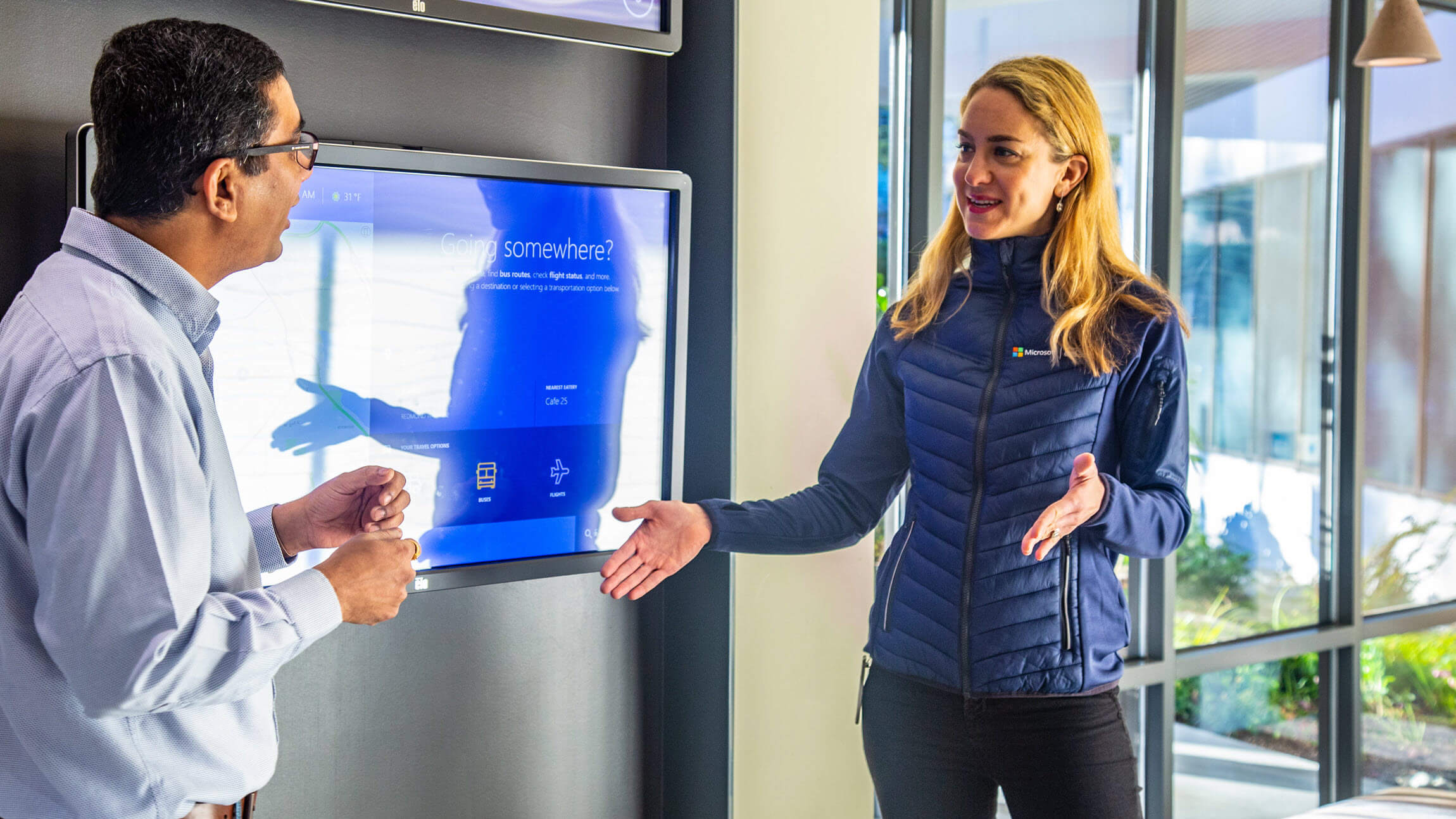 You learn a lot about someone when you pass through their front door.
You learn a lot about someone when you pass through their front door.
Microsoft is no different.
The company is retooling the experience visitors have when they walk into Microsoft’s many front doors—the company has more than 770 buildings around the world, including more than 100 at its headquarters in Redmond, Washington.
“Each building has a lobby designed specifically for it, and greets you in the same, consistent way,” says Esther Christoffersen, senior services manager for Microsoft Real Estate and Security (RE&S). “When people enter a Microsoft lobby, they should feel welcome, a sense of comfort and ease. They should feel connected to the place and the people.”
And when she says everyone, she means it.
“I’m talking about customers, partners, contingent staff, interview candidates, other guests, maybe family and friends—maybe it’s someone making a delivery on campus,” she says. “Equally important, employees come through our lobbies every day.”
Additionally, with check-in desks offering two height options and well-marked signage, the experience is also more accessible for people who use wheelchairs and those who have visual impairments.
Providing the right welcome experience starts with the host at the reception desk who’s there to greet you, but it extends to the technology as well. “We think about the end-to-end arrival and departure experience,” Christoffersen says. “This is where we bring the physical and digital space together.”
Microsoft is in its third year of a four-year journey to rollout the lobby experience across the company, a partnership between RE&S and Microsoft Digital, the IT portion of Microsoft providing the technology behind the new experience.
‘Hello, welcome to Microsoft’
The Microsoft lobby upgrade comes in two modules, one for arrival and one for departure,” says Vishu Admal, the Microsoft Digital program manager leading the technology portion of the lobby experience upgrade.
On the arrival side, the first goal is to get the visitor signed in and registered as quickly as possible.
“It starts before our guests arrive, when their host schedules their meeting with them in Outlook,” Admal says. “Visitors get an invitation email that includes a QR code they can use to check in.”
The visitor scans the QR code at an arrival kiosk, gets signed in, receives a personalized visitor badge (with an avatar of their choice), chats with the host, and, coming soon, will get connected to secure Wi-Fi.
“It’s about making sure it’s a quality experience,” Admal says. “We want it to be pleasant, with a balance of speed and comfort.”
Providing seamless access to a secure Wi-Fi network was particularly vexing for a surprising reason. “It used to be that Microsoft offered an open network,” Admal says. “But mobile cafés started springing up next to some of our offices touting ’free Microsoft Wi-Fi.’”
Because of that, the company had to restrict its public Wi-Fi, and that caused issues for guests who had to wait for approval from their host to get access. Hosts often didn’t see these Wi-Fi requests, so there were delays or they never got access.
That wasn’t a good experience for the typical Microsoft guest, who likes to arrive early so they can relax and check email before their meeting (especially job interview candidates).
It was a challenge that needed to be solved.
“We’re fixing it with a back-end handshake,” Admal says. “Now all a guest has to do is check in and we automatically send them a Wi-Fi password. We’re keeping Microsoft secure, and at the same time, taking this big headache away.”
‘Thank you, we hope you enjoyed your stay’
Departures at Microsoft are about helping visitors get to their next destination.
The new departure experience features two large screens placed prominently in each lobby, one showing all the places a guest can go next, and the other showing what shuttles are in transit to that building.
“Seeing it play out dynamically on a big screen reassures them that everything is going to be OK, that a shuttle is really on the way,” Admal says.
About 40 percent of all shuttle traffic is booked from lobbies. The main screen is set up so someone can book a trip with a couple of taps. And, most importantly, the person doesn’t have to authenticate themselves, which makes it easier for non-employees to get around campus.
This main screen gives the user a lot of information—it syncs with the regional bus network, taps Bing for airline flight information, updates the weather, and provides other useful information.
The departure experience has been installed in 103 buildings, including 65 buildings at company headquarters. The goal is to install the lobby experience to all company buildings that use shuttles.
Creating an experience for everyone
When visitors experience a new Microsoft lobby, they like what they see, so much so that some have asked if they can take it home with them.
“We can replicate the technology for our customers when they ask for it,” Admal says. “Most of the experience is built on Microsoft technology, including Azure. We integrate with third party suppliers for services they provide at Microsoft, and customers who want to adopt this can customize it with their service providers.”
Recently, a large company from India saw how the lobby experience works and asked for it, and now Microsoft Consulting Services (MCS) is helping the company install it.
“They deployed it at their headquarters and are considering it for all of their lobbies,” Admal says. “The solution can be tailored for the customer—they can design it just the way they want.”
Christoffersen says the fact that other companies are interested in the new lobby experience is a good sign, suggesting that the efforts by RE&S and Microsoft Digital to transform what it’s like to walk into a Microsoft building are working.
“We’re always testing and learning so we can get better,” she says. “We don’t have it all figured out—we’re going to keep working hard to make a good first impression.”


